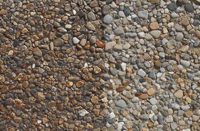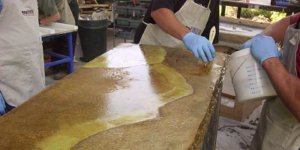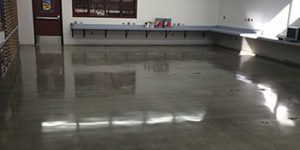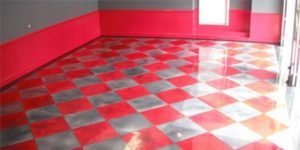
There are a lot of sealers in the marketplace today, probably more than ever before. And, while that can be a good thing — think plenty of choices — it also brings up more questions about whether you’re choosing the right concrete sealer for a given job.
You can certainly seal and run. After all, sealing comes at the end of a project, with that check close enough to taste. Still, as the last component to a job, using the proper sealer is also the most important ingredient for avoiding future issues.
So, what’s the right answer? In a nutshell, it involves educating your customer to realistic expectations, then spending the time to research those products to a point where you feel comfortable applying your best answer.
Sealing for success
The reality is not every concrete job needs a sealer, but those that don’t are pretty few and far between.
“Those would include things that are vertical, things that aren’t wear surfaces, some forms of sculpture or art. In other words, nonfunctional forms of concrete,” says Chris Becker, director of technical services for Springfield, Illinois-based Solomon Colors/Brickform. “But, if it’s underfoot, you’d better put something on it. Absolutely.”

Bob Chatterton, owner of Trinic in Kirkwood, New York, says it doesn’t even have to be underfoot. He notes that there’s a definite need to seal concrete countertops from stains and organic and citric acids that can etch a concrete surface.
Speaking more broadly than just about countertops, Chatterton adds, “Generally, sealing stained or stamped concrete not only protects it, but helps lock the color in to make it last longer and look better.”
Lots of opinions
From there, it gets complicated. Not only are there a lot of different types of sealers for various applications, but Justin Vollmerhausen, a contractor who owns Colorado Hard Surfaces in Denver, says there are probably just as many opinions about what kind of sealer should be used on a given type of concrete for a specific type of result.

“You can take one type of concrete and a family of sealers from some of the different manufacturers, and you’re going to have people from each say, ‘This is the best,’ ‘No, this is the best,’ ‘No, mine is the best,’” he says. “There’s no one best way to answer that question because there are so many different ideas.”
Still, not all sealers are created equal. The fact that some are made with penetrating formulas while others are decorative coatings is a good example.
“Penetrating sealers migrate deep into the concrete and with the latest advances in nano-technology they can penetrate deeper than ever, providing unparalleled protection from within,” says Hermine Basso, director of business development for Ghostshield in Hudson, New Hampshire. “Decorative coating-style sealers are more geared toward protection, providing a coating on the concrete surface.”
And, while penetrating sealers tend to leave the concrete with a natural, unchanged finish, decorative coatings come in a variety of sheens, or even more durable epoxy- or urethane-style coatings, she says.
Variables galore

The questions a contractor needs to consider before deciding on a correct sealer can seem almost endless.
“You need to look at every variable,” says Keith Boudart, national sales manager for Aurora, Illinois-based Butterfield Color. “What’s the situation? Where will you use the sealer? What’s the potential longevity of the product? What is the decorative application? What is the climate? And what type of traffic will the surface have? Who’s applying the sealer and at what thickness?”
Even a seemingly simple question, such as whether the job is indoors or outdoors, can bring up several issues. For instance, is the job in the Midwest, where salt is a given not just on exterior concrete but can be tracked into a home or business? Or is it in the Southwest, where sun can be the primary issue?
Odors part of the equation
One important consideration on the indoor versus outdoor location of a job is the odor of solvent-based sealers. Douglasville, Georgia-based Scofield has recently released a new line of solvent-based sealers that has reduced VOCs (volatile organic compounds) which contribute to air pollution. Still, managing director Art Pinto says they have a strong odor and require a mask for interior use.
“For interior it’s more challenging to use a solvent-based product,” he says. “Water-based products are often for interior use, but you still have to look at the use of the floor. If it’s a residential job you may not need a very high-performance sealer. But if it’s a restaurant or commercial floor in a mall, you’ll want to use a higher-performance sealer because resealing (and repairing) is expensive and complicated.”

Consider composition
Often a higher-performance sealer has multiple parts. Solomon Colors’ Becker says those perform best on interior applications where heavy traffic is the rule. However, they can protect exterior surfaces with heavy traffic, as well.
“They have a thicker composition which can be used for deterring any kind of chemical or oil penetration,” Becker says. “They’re also typically chemical resistant and resist wearing and scuffs.”
Still another consideration is the actual composition of the concrete surface, particularly whether it’s very smooth or not.
“If concrete is polished, solvent-based products will typically penetrate better,” says Ghostshield’s Basso. “The polishing process closes off the surface pores and solvents are better suited to carry the varying molecular particle sizes into the substrate.”

Not every job can wait
Finally, there’s the question of timeframe. In a perfect world, sealing would be done after new concrete has had a chance to cure. However, not every job can wait. So some companies turn to other products to avoid trapping moisture from the concrete. This is especially true under water-based sealers.
One of the newest products on the market to deal with that issue is Butterfield Color’s Clear Guard First Seal.
“It’s basically a water-based reactive product that can be applied at 48 hours after pouring the concrete,” says Boudart. “It helps minimize the effect of freeze-thaw and deicing salts, but it also promotes adhesion of a topical sealer. So, once it’s thoroughly dry you can apply a solvent-borne acrylic sealer over the surface.”
When in doubt
As if those situations can’t be complicated enough, then there are those where a customer wants you to reseal someone else’s work. And possibly neither you nor the client will know the sealer type originally applied.
Scofield’s Pinto offers a couple of suggestions on that. He says if the original sealer is still in good shape, you can probably safely apply a solvent-based sealer. However, pretesting is always a good idea.
If you want to go the water-based route and you’re unsure of what’s underneath, “Do a very good cleaning. Next, sand the area lightly so the sealer will adhere and then prepare the sealer.” Pinto says.
That’s somewhat the situation Vollmerhausen was in a few years ago. He explains that a residential owner called Colorado Hard Surfaces looking for help with a stamped patio. It was beginning to spall within a couple years of construction.
Vollmerhausen says he knew he could repair the spalling. But, “I knew if I fixed his patio, I was going to need something more permanent than a simple acrylic to protect his patio and keep water out.”

Nothing lasts forever
Although he used Super-Krete Products’ SK-P250 polyurethane on commercial floors with great success, he contacted both his manufacturer’s rep, Mark Haen, and local sales rep before choosing to apply it to the exterior stamped concrete.
“The P250 is UV stable, and is thick enough to hold nonslip products,” Vollmerhausen says. “Colors won’t fade, sealant does wear and there’s a great texture for slip resistance. It’s the only product we use now for sealing stamped concrete because it lasts. I’ve got four-year-old patios you’d think were new.”
Not that his success with the product hasn’t come without a little work. He says the patio must be absolutely clean. Additionally, you must remove the old sealer entirely and roll it on, rather than spray it.
The client also needs to buy into paying more upfront for a premium product and application in exchange for not having to reseal every year or two. In general, each client needs to know that expecting a concrete sealer to remain unchanged after years of weather and/or manmade abuse is unrealistic.
The bottom line: get all the information you can before choosing a sealer, and then follow directions.

“If you’ve got a question, ask somebody who knows,” advises Trinic’s Chatterton. “Talk to someone who sells or manufactures sealers that’s well-versed in both the benefits and the cautions of things that can go wrong. Remember, every project is always a little bit different. And, remember, the sealer isn’t going to perform the best it can if it’s not applied the way it should be.”
www.butterfieldcolor.com
www.cohardsurfaces.com
www.ghostshield.com
www.scofield.com
www.solomoncolors.com
www.trinic.us















